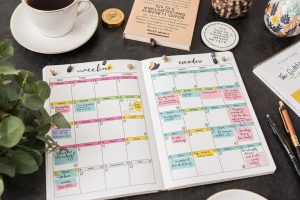Why you need a goal system that works Month-to-Week
Let’s be real, how many times have you set a goal, felt super hyped about it, and then… nothing. Two weeks in, the notebook’s gathering dust, the gym shoes are back in the closet, and you can’t remember where you wrote your “big plans.”
It happens. A lot.
But here’s the thing: most people don’t fail at goals because they’re lazy or unmotivated. They fail because the plan wasn’t built to last. Big dreams need bite-sized, real-life structure. That’s where monthly planning and weekly reflection come in. It’s not just about “setting goals” anymore, it’s about designing a system that keeps your momentum going even when life gets weird (because it always does).
I used to be the “fresh notebook every January” type too. Full of ideas, color-coded tabs, maybe a quote or two. But no system. No follow-through. Now? I don’t set goals without anchoring them to a month and a weekly check-in. It sounds small, but this shift? Total game-changer.
Before we get into tools and templates, just know this: you don’t have to do everything perfectly. You just need to start with a system that’s flexible and reliable. That’s what we’re getting into here.
Need a big-picture refresh? Head over to Why most people fail at goals to see how this fits into your overall strategy.
The power of monthly planning
So why monthly?
Think of it like a season in a TV show. Long enough to develop the story, short enough to keep your attention. A month gives you a nice rhythm, four weeks of intention, action, and gentle course-correcting. It’s just enough time to make progress without feeling like you’re waiting forever to feel results.
For me, monthly planning is where the magic happens. You’re not trying to plan a whole year in one go (which, let’s be honest, never works out). You’re zooming into just 30 days. That’s manageable. That’s something your brain and schedule can actually handle.
And it’s not about rigid structure. In fact, I’d argue that the more you personalize your monthly plan, the more likely you are to stick with it.
What a great monthly planning template should include
There’s no one-size-fits-all, but there are some core pieces that make a monthly goal planner truly useful:
-
Main goal categories – Maybe it’s work, health, personal growth, family, or something else. Define your focus buckets.
-
Milestones or checkpoints – Not everything can be done at once. Break it down into “mini wins.”
-
Task breakdown – What actions do those milestones actually require?
-
Habit tracker – This is huge. Even a simple yes/no on whether you drank water or read today can reinforce momentum.
-
Calendar or visual space – Because seeing your month helps make it real. A checklist is great, but a timeline is better.
It doesn’t have to be pretty. It doesn’t even have to be digital if you’re more of a pen-and-paper type. But it does need to feel like you.
One of my favorite discoveries? Using Notion templates for monthly planning. They’re super customizable, you can literally drag and drop your entire life into a digital dashboard. And the best part? If you find the right one, you don’t have to build it from scratch. (Here’s a roundup of the best digital planners to start with.)
Notion templates: Flexible & surprisingly addictive
Look, I didn’t think I’d be a Notion person either. But here we are.

The thing is, Notion makes planning feel kind of… fun? At least, more interactive. You can switch views (calendar, list, kanban), track progress bars, set reminders, and embed literally anything, from a YouTube video that pumps you up, to your grocery list.
There’s one specific template I’ve been using lately that has tabs for each major life area, monthly reflections, priority tracking, and even a little built-in habit checker. It feels like a second brain but way more organized than my actual one.
You could totally make your own, but I’ve seen some creators put together beautiful goal-setting dashboards that are worth every click.
And if Notion’s not your vibe, that’s okay. The key idea is to find a system that lives where you do, your phone, your laptop, your journal, wherever you’re most likely to check in, adjust, and keep going.
How to actually use monthly templates without burning out
Okay, now you’ve got your planner, what next?
Start with this rhythm:
-
Brain dump what’s on your mind for the month ahead.
-
Pick 2-3 big goals max. Don’t overload yourself.
-
Break each goal into smaller steps, then distribute those across the weeks.
-
Use your habit tracker to keep an eye on daily consistency (not perfection).
-
Leave white space. Life will fill in the blanks. Always.
Also, be willing to change it up mid-month. I used to feel like adjusting my plan meant I’d failed. But honestly? Pivoting means you’re paying attention. That’s real success.
Why weekly reviews are game-changers
Let’s be honest: a monthly plan without weekly check-ins is like planting seeds and never watering them.
Weekly reviews are where the real-life feedback happens. You get to ask yourself, “Did I actually do what I said I’d do? And if not… why?” It’s not about guilt-tripping yourself. It’s about creating space to be honest, to adjust, and to stay engaged with your goals before they drift into the background of your busy life.
Personally, my weekly ritual is a sacred little moment. Usually Sunday night, sometimes Monday morning with coffee. I sit down, open up my planner (or Notion, depending on my mood), and just take 15–20 minutes to check in.
There’s something really grounding about looking at what went well, what totally flopped, and what still matters. If you’re curious, here’s a breakdown of a simple weekly ritual you can try.
A simple weekly review ritual you can actually stick with

Don’t worry, this isn’t one of those “50 prompts and color-coded tables” kind of routines. Keep it light. Keep it doable. Here’s a structure I’ve used that’s simple enough to stick with, even on chaotic weeks:
-
Celebrate the wins
Big or small. “I finished that project.” “I drank more water.” “I didn’t ghost my planner.” Whatever felt like a yes this week, note it. -
Notice what felt off
Did something drain your energy? Did you overcommit? Did a habit not stick? It’s not failure, it’s just data. -
Revisit your monthly goals
Where are you with them? Is this week moving you closer or are you stuck in maintenance mode? -
Pick your Big 3 for the week ahead
What are the three most important actions, outcomes, or focuses you want to prioritize? Just three. No overloading. -
Sketch a light schedule
Block the time. Even if it’s flexible, seeing your week makes it less overwhelming.
I’ve even started adding a “How did I feel this week?” line just to get a vibe check. Some weeks I’m clear and focused. Others? Cloudy with a chance of burnout. Both are useful to know.
The productivity planner: My favorite tool for this
Now, if you’re more analog and like having something you can touch, I’ve got to tell you about The Productivity Planner from Intelligent Change.
This little book surprised me. It’s not bulky. It’s not overdesigned. But it walks you through exactly what I just shared above, with thoughtful prompts, daily focus planning, and even a Pomodoro tracker if that’s your thing.
You can use it alongside your digital monthly planner (like a Notion dashboard) or just on its own. What I love is that it builds in reflection without feeling cheesy or over-coached. It’s made for real people who want to get stuff done and feel good doing it.
Why the monthly + weekly combo works so well
Monthly planning gives you direction. Weekly review gives you traction.
It’s like setting your GPS destination at the start of the month… but checking your route every week to make sure you’re not headed into a traffic jam or veering off into a ditch. Together, they create this smooth rhythm where you’re always a little bit focused, a little bit flexible, and totally in tune with your priorities.
And let’s be clear: you don’t have to be perfect. If you miss a weekly review? No panic. Just pick it up again. This is about systems, not streaks.
Over time, these tiny reviews stack up into real transformation. You look back after a few months and realize you’ve actually done the things you set out to do. That’s the power of aligned action.

Build a monthly-weekly planning flow that actually sticks
So here’s what I hope you take from all this:
-
You don’t need to “do more.” You just need to do the right things with more clarity.
-
Monthly goal templates (especially with flexible tools like Notion) help you define what matters.
-
Weekly review rituals keep those goals alive, personal, and totally adaptable.
-
The combo creates a feedback loop that keeps you focused without burning out.
I’m not exaggerating when I say this simple planning rhythm changed how I work, create, and even rest.
Try it. Start small. See what shifts. And if you ever fall off? Just begin again, one week at a time.



